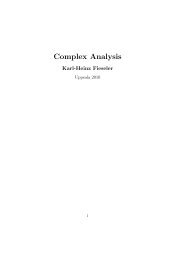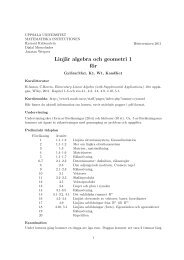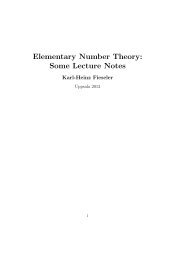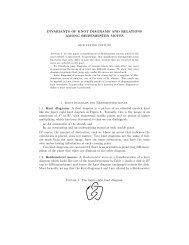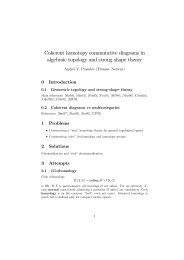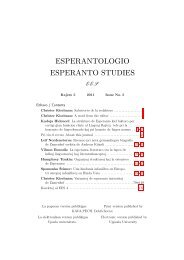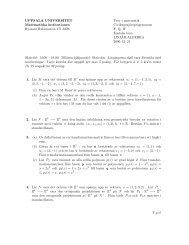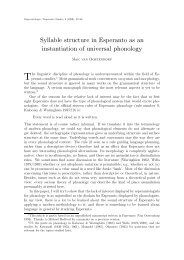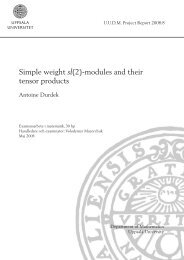that Cauchy didn’t mention this property ei<strong>the</strong>r in his treatment <strong>of</strong> definiteintegrals between real limits.Now Malmsten calls∫ zF (z) = f(z)dz (13)z 0and shows that F (z) is synectic in <strong>the</strong> same domain as f(z). This is analogousto what Cauchy showed for definite integrals between real limits,namely that F (z) is differentiable in <strong>the</strong> same domain as f(z).The last property to show isHere Malmsten uses expression (13) and putsF ′ (z) = f(z). (14)F (z + δ) − F (z) =∫ z+δzf(z)dzand <strong>the</strong>n uses an earlier corollary (about weighted mean values) to getF (z + δ) − F (z) = δf(z + α) · θ · e pi ,where α is a ’mean quantity’ to 0 and δ (and <strong>the</strong>refore converges to 0 at <strong>the</strong>same time as δ) and θ · e pi converges to 1 at <strong>the</strong> same time as δ convergesto 0. From this formula he getsF (z + δ) − f(z)lim = F ′ (z) = f(z).δHence, by proving <strong>the</strong> existence <strong>of</strong> <strong>the</strong> integral (1), and <strong>the</strong>n showingthat <strong>the</strong> properties (10)-(14) holds, Malmsten has now completed his pro<strong>of</strong><strong>of</strong> <strong>the</strong> integral <strong>the</strong>orem (for integrals where <strong>the</strong> limits <strong>of</strong> integration arecomplex numbers) analogous to how Cauchy proved <strong>the</strong> integral <strong>the</strong>oremfor integrals between real limits.6 Final RemarksMalmsten left Uppsala at <strong>the</strong> end <strong>of</strong> <strong>the</strong> 1850s to get into politics (seeabove). His successor Herman Daug (1828-1888), whose ma<strong>the</strong>matical researchmostly concerned differential geometry, didn’t have much influence[3]. Instead, in <strong>the</strong> 1870s, <strong>the</strong> ma<strong>the</strong>matical education and research in Uppsalacame to be characterized by Göran Dillner (1832-1906), who had agreat interest in Cauchy’s works <strong>of</strong> analytic functions. But Dillner’s lacking20
knowledge <strong>of</strong> analysis resulted in a relatively unpr<strong>of</strong>essional way to do research[3]. However, along with Mittag-Leffler, who came under influence <strong>of</strong>Karl Weierstrass (1815-1896), <strong>the</strong> <strong>the</strong>ory <strong>of</strong> analytic functions got clearedup. In fact, it was in Germany, with Bernhard Riemann (1826-1866) andWeierstrass, <strong>the</strong> <strong>the</strong>ory <strong>of</strong> complex functions followed an autonomous path<strong>of</strong> development that went far beyond what had been set out by Cauchy [2].Thus, <strong>the</strong> intuitive apprehension <strong>of</strong> <strong>the</strong> analytic functions that had characterized<strong>the</strong> nineteenth century now became rigorous.Malmsten wrote his pro<strong>of</strong> <strong>of</strong> <strong>the</strong> integral <strong>the</strong>orem some years before <strong>the</strong>breakthrough <strong>of</strong> Weierstrass’ strict analysis and <strong>the</strong>refore his statement <strong>of</strong><strong>the</strong> pro<strong>of</strong> doesn’t reach present-day standards. Although, it seems it keptup to <strong>the</strong> standards <strong>of</strong> his time. However, <strong>the</strong> merit <strong>of</strong> Malmsten is to havesorted out condition (7), even if he didn’t use it in Green’s formula. Thepro<strong>of</strong> also shows Malmsten’s ability to treat inequalities as well as Riemannsums. Fur<strong>the</strong>rmore, it is said that Mittag-Leffler, who at <strong>the</strong> beginning<strong>of</strong> his career had been one <strong>of</strong> Malmsten’s students, was complaining thatMalmsten’s, as well as his own, pro<strong>of</strong> didn’t end up in “Enzyklopädie derMa<strong>the</strong>matischen Wissenschaften” [3]. Maybe this was due to <strong>the</strong> fact thatMalmsten’s successor Daug didn’t keep up <strong>the</strong> research in <strong>the</strong> <strong>the</strong>ory <strong>of</strong>analytic functions.References[1] Belhoste, B. (1991). Augustin-Louis Cauchy. A Biography. New York:Springer-Verlag.[2] Bottazzini, U. (1986). The Higher Calculus: A History <strong>of</strong> Real and ComplexAnalysis from Euler to Weierstrass. New York: Springer-Verlag.[3] Gårding, L. (1994). Matematik och matematiker. Matematiken i Sverigeföre 1950. Lund: Lund University Press.[4] Kolmogorov, A.N., Yushkevich, A.P. (1996). Ma<strong>the</strong>matics <strong>of</strong> <strong>the</strong> 19thCentury. Basel: Birkhäuser Verlag.[5] Malmsten, C.J. (1865). Om definita integraler mellan imaginära gränsor.Kungliga Svenska Vetenskaps-akademiens Handlingar. Bandet 6. N:o 3.[6] Sjöberg, B. (1998). Från Euklides till Hilbert: historien om matematikensutveckling under tvåtusen år. Åbo: Åbo Akademis förlag.21




